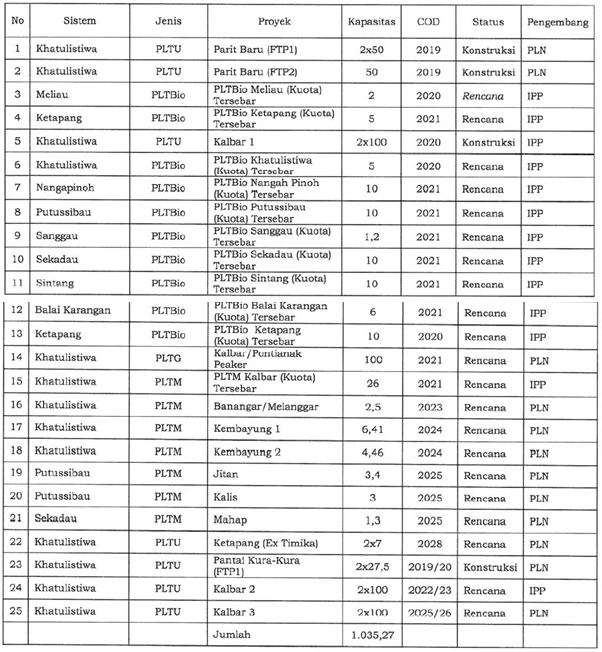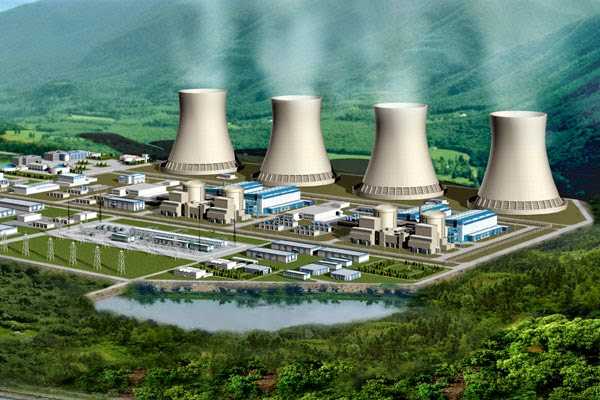By: Haryanto
This research opinion presents some perspectives on the nuclear power plant development in West Kalimantan and its potential impacts. This article starts with a brief introduction of West Kalimantan, followed by a deeper explanation of the potential impacts of nuclear power plants on the environment and economy.
Introduction
West Kalimantan is rich in natural resources potential for energy, such as hydro, biomass, coal and uranium. West Kalimantan is well-known with its palm oil plantation waste that can be utilized for biomass power plants (PTLBm). Besides, Sintang, Melawi, and Kapuas Hulu have around 160 million tons of high calorific coal (4,795-7,880 kcal/kg). Apart from coal, Melawi regency has reserves for uranium that can be utilized for nuclear power plants (RUPTL PT PLN 2019-2028).
Despite its abundant energy resources, the ratio of electrified households in West Kalimantan until 2016 was 78.20%. To date, most of the electricity supply in West Kalimantan comes from oil-based power plant. The sufficiency and reliability of this system are still relatively low due to the inadequate reserve and aging diesel power plant (PLTD). Currently, PLN also buys an electricity supply of 230 MW from Sarawak to fulfill the baseload requirement (100 MW) and peak load (130 MW) in a span of five years (2016-2021) (RUPTL PLN 2019-2028). This situation shows the need for exploration of other alternative sources for electricity generation, as West Kalimantan has the resources.
In West Kalimantan, should the renewable resources be fully optimized, it could contribute to the government’s aim to achieve a 23% new and renewable energy mix in the national scale under the Presidential Regulation No. 22/2017 on National General Energy Plan (RUEN). Despite many renewable energy resources in West Kalimantan, the scope of this article is only on the nuclear power plant development in West Kalimantan.
Many institutions have put their attention on developing the nuclear power plant (NPP) in West Kalimantan. Based on some news (Oxtora, 2019; Wiratmini, 2019), it can be seen that the government shows positive supports for the NPP development in West Kalimantan. NPP is expected to operate in West Kalimantan starting from 2025. Some institutions have started planning to develop the nuclear power plant in West Kalimantan. For example, a nuclear power plant (ship design) with a capacity of 500 MW is being developed by PT PAL Indonesia and Thorcon Internasional Pte. Furthermore, this nuclear power plant will use Thorium Molten Salt Reactor technology and is designed to use thorium or tin waste and thus, lowering its operational cost (Sulmaihati, 2019).
Interestingly, the NPP development in West Kalimantan is not stated yet in the RUPTL PLN 2019-2028 as shown in Table 1. Based on RUPTL, PLN and IPP would focus on developing mini-hydro (PLTM), steam-fired power plant (PLTU), biomass power plant (PLTBm), and gas power plant (PLTG).

Hence, if we develop a nuclear power plant in West Kalimantan, what are the possible environmental, social, and economic impacts? In most cases, there would be pros and cons related to any power plant development.
The Environmental Impacts
In terms of environmental impacts, soil, water, and air quality are concerns. Regarding this, nuclear power plant excels in the better air quality, compared to fossil fuel-fired power plants. During the operation, the power plant does not emit carbon dioxide and other hazardous air pollutants (EIA, 2019).
Despite its benefits to the environment, there are some potentially negative impacts of this nuclear plant. The followings are some environmental disadvantages for the environment.
- The carbon dioxide emitted during the uranium/thorium mining and refining process and its transportation to the nuclear power plant. Similar to fossil fuel, the source of nuclear energy also requires exploration and exploitation of the earth’s resources, in particular mining and refining process. All of these processes require a large amount of energy which likely comes from fossil energy.
- Nuclear waste generated: high-level waste (leftover from nuclear waste) and low-level waste (equipments contaminated with radioactive material). This is a debatable topic as the current technology, reactor generation 4.0 is already sufficient to handle the waste.
- The nuclear waste cooling system needs a huge amount of water from the surrounding area.
- Potential change of landscape due to the nuclear power plant development.
The Socioeconomic Impact
The development of nuclear power plant in West Kalimantan could foster the socio-economic growth in the region, even at the national scale, thanks to the ripple effect.
For example, PT Inalum (Persero) with PT Antam Tbk through their subsidiary company, PT Borneo Alumina Indonesia (PT BAI), plan to develop alumina refinery smelter at Bukit Batu Village, Mempawah Regency, Kalimantan Barat. This strategic project is a part of the mining hilirization industry. The smelter operation requires an enormous amount of energy and thus, it is accompanied by the development of coal power plants (3 X 25 MW) (Pablo, 2019). The presence of such smelter enables higher value exports, such as alumina or aluminum, instead of exporting the raw bauxite ore. Furthermore, the development of this smelter is likely driving other aluminum-related industries and other industries to be developed in the region. To this end, development of nuclear power plant could beneficially supply the electricity needed to run this smelter.
Nevertheless, the economic impact is not only limited to the local people but also for the government. If the electricity generation cost (BPP) of nuclear energy is higher than the BPP set by the government, which is 10.70 cents US$/kWh for West Kalimantan, in accordance with the MEMR Decree 55K/20/MEM/2019, then there would be parties that would bear the financial burden. However, some studies discussed in World Nuclear Association (2019a) show that BPP for nuclear energy is lower than fossil-fueled power plant. This implies that nuclear energy is more economically attractive. But, assumptions used in these studies should be taken into caution as total cost for any power plant would be highly dependent on the construction location.
Regardless of the positive contribution to the economic growth that NPP could bring, there is still a negative image of NPP in Indonesia. The acceptance of local people for the NPP development in their living area is a concern. Particularly, after the Fukushima accident, the third-worst nuclear accident after Three Mile Island in the US and Chernobyl in Russia (Akiyama et al., 2012; World Nuclear Association, 2018), many countries plan to phase-out from the NPP. The negative image of the NPP brought by this accident is inevitable. However, according to BATAN research in World Nuclear Association (2019b), national acceptance of nuclear power is increasing and had increased to 77.5% in 2016 compared to 72% in 2014.
Conclusion
In regard to the mentioned issues, the followings are some recommendations that can be offered.
- A thorough and rigorous feasibility study is required prior to the development of the nuclear power plant.
- The mining of uranium and thorium necessitates clear laws and regulations for the related stakeholders. In addition, the operation of the nuclear power plant and treatment of radioactive waste generated must be clearly regulated.
- Collaborate with international organizations / private stakeholders that have more experience in managing a nuclear power plant to promote knowledge and technology transfer.
- Preparation of the human capital for nuclear power plant management.
The key enabler to make this nuclear power plant development in West Kalimantan possible is the synergy between the government (both national and local), research institutions, for instance, National Nuclear Energy Agency of Indonesia (BATAN), local people, private institutions (investors). Ultimately, the development of the nuclear power plant has the opportunity to increase Indonesia’s energy security and accelerate economic growth.
Bibliography
Akiyama, N., Sato, H., Naito, K., Naoi, Y., & Katsuta, T. (2012). The Fukushima nuclear accident and crisis management-lessons for Japan-US alliance cooperation. The Sasakawa Peace Foundation. Retrieved from
https://www.spf.org/en/_jpus_media/img/investigation/book_fukushima.pdf
EIA. (2019, January 16). Nuclear explained: Nuclear power and the environment. Retrieved from https://www.eia.gov/energyexplained/nuclear/nuclear-power-and-the-environment.php
MEMR Decree 55K/20/MEM/2019 on Electricity Cost Generation (BPP) of PLN. (2019, March 29).
Oxtora, R. (2019, September 25). Untuk PLTN, Kalbar terus dorong BATAN lakukan kajian. ANTARANEWS.com. Retrieved from https://www.antaranews.com/berita/1081138/untuk-pltn-kalbar-terus-dorong-batan-lakukan-kajian
Pablo, S. (2019, April 07). Inalum-Antam Bangun Pabrik Smelter Alumina di Kalbar. Jakarta: CNBC Indonesia. Retrieved from https://www.cnbcindonesia.com/news/20190407154934-4-65079/inalum-antam-bangun-pabrik-smelter-alumina-di-kalbar
Presidential Regulation No. 22/2017 on National General Energy Plan. (2017, March 02).
RUPTL PT PLN 2019-2018.
Sulmaihati, F. (2019, July 17). PT PAL Kembangkan Pembangkit Listrik Tenaga Nuklir di Laut. katadata.co.id. Retrieved from https://katadata.co.id/berita/2019/07/17/pt-pal-kembangkan-pembangkit-listrik-tenaga-nuklir-di-laut
World Nuclear Association. (2018, October). Fukushima Daiichi Event. Retrieved from https://www.world-nuclear.org/information-library/safety-and-security/safety-of-plants/fukushima-accident.aspx
World Nuclear Association. (2019a, September). Economics of Nuclear Power. Retrieved from https://www.world-nuclear.org/information-library/economic-aspects/economics-of-nuclear-power.aspx
World Nuclear Association. (2019b, February). Nuclear Power in Indonesia. Retrieved from https://www.world-nuclear.org/information-library/country-profiles/countries-g-n/indonesia.aspx
Wiratmini, N. P. (2019, August 16). DPD RI Dukung Pembangunan PLTN di Kalimantan Barat. Retrieved from https://ekonomi.bisnis.com/read/20190816/44/1137384/dpd-ri-dukung-pembangunan-pltn-di-kalimantan-barat
*This opinion piece is the author(s) own and does not necessarily represent opinions of the Purnomo Yusgiantoro Center (PYC)







